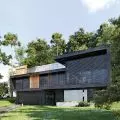The article is from A&B issue 7-8|23
Urban chaos is the biggest spatial problem in Poland. Marta Kulawik discusses the problem with Łukasz Drozda, who speaks from the perspective of a political scientist and author of several books on urban planning, Piotr Mazik, who answers questions as an art historian, high-altitude guide and, above all, a Zakopanian, and Marek Kaszynski, recently chairman of the council of the Malopolska Regional Chamber of Architecture.
Piotr Mazik - art historian, alpine skier, alpine guide, ski instructor. Author of the book "Tatra Atlantis." He lives in Zakopane. Together with Maciej Krupa and Kuba Szpilka, he founded and runs the Foundation "Zakopiańczycy. In Search of Identity." They have written several books together: "Zakopiańczycy. In Search of Identity," "Traces, Trails, Paths. Among the Tatra and Zakopane imaginations", "The Absent City. A guide to the unknown Zakopane". They are authors of many exhibitions and constantly cooperate with the Tatra Museum and the quarterly magazine of the Tatra National Park "Tatry".
Marta Kulawik:You are a co-founder and board member of the foundation "Zakopiańczycy. In Search of Identity," which has been officially operating since 2012, but you have already been active in promoting the Podtatrze, the Tatra Mountains and Zakopane, among other things, before that, together with the other creators - Maciej Krupa and Kuba Szpilka. You are a Tatra guide and art historian by education. Could it be said that you are a Zakopanian by avocation?
Piotr Mazik:I am a Zakopanian by birth and by choice. This is where I was born and raised, and this is where I decided to stay. Zakopane is an important part of my identity. Apart from my family, it is the place of birth that has built me up the most. Identity is never finished, it is in change. However, there are strong points in it, and Zakopane is certainly such an element. Maciek and Kuba and I have been trying to talk about the place in this way for years. We raise topics that are weakly present, we juxtapose them with the dominant narrative. We interpret, we point out the many contexts of this place. I'm certainly passionate about being a member of our foundation.
Marta:The foundation is also involved in educating about the history and heritage of the region. When it comes to nurturing heritage in the capital of the Polish mountains, as Zakopane is called, there is a lot to do. What kind of activities does the foundation undertake?
Piotr: During these more than ten years we have done a lot.The first half of our activity was a time when, using sources, we "spoke". For the past few years we have been trying to create sources and give voice to others. We give talks, digitize, point out spaces that are important, but for various reasons absent.
Marta: This material is dedicated to spatial chaos. It is impossible not to look at Zakopane and its surroundings through this prism. Krupówki deprived of its former charm, Gubałówka, Wielka Krokiew or Siwa Polana full of stalls with Chinese food and fast food stalls, or roadside billboards obscuring the Tatra Mountains are just some of the deficiencies in space. Where have the folklore, local food and handicrafts gone?
Piotr: When we use these terms, we relate them to imaginations or memories. They are part of the Zakopane imaginarium. Our Zakopane world is mythicized. The shortcomings of our reality are precisely the dominant part of folklore, local food and handicrafts. More, it can be said that it has always been this way. There were no times of perfect, "uncontaminated" folklore. Folklore is built with encounters, changes. And this construction will never end. And if it ends - folklore will die. I will never defend the clapboard booths standing in Zakopane, but I understand that another - elitist, beautiful - Zakopane never existed. In a way, chaos is creative. Unfortunately, over the years, bad taste, trash and temporariness gain the upper hand here. There are unbearable places in it. These are exactly the ones you mentioned. Years later, I think Zakopane may be some kind of story about Poland in general. Here various phenomena are cumulative, glaring and gathered in one place. In this sense, the ugliness is fascinating, because that's what we are at this historical moment.
Marta: Historic architecture is disappearing from the streets of Zakopane. Some buildings are burning in strange circumstances, and others, seemingly legally, are being expanded in such a way that they no longer resemble their original version. Let the brick Monte Villa, designed by Karol Stryjeński, already hailed as a Macabre during its reconstruction, serve as an example. Who is responsible for this irrevocably disappearing architectural heritage, and will they ever be held accountable?
Piotr: It is pointless to pull the wool over our eyes. Architects and investors are responsible. Laws are always a step backward from life. Their imperfection should not be used to explain bad architecture. There will always be a loophole to transgress. Respect for history, neighborhood, common good, cultural landscape is part of good manners, upbringing, and in an architect also class, education, awareness. If this is missing, we all lose.
Zakopane can be some kind of story about Poland in general - here various phenomena are accumulated, bright and gathered in one place
Photo: Tomasz Fudala © redroxmedia Pixabay
Marta: Chaos and thoughtlessness affect not only monuments, but also natural heritage. Theoretically, a local zoning plan has been developed, but, as you can see, it does not prevent the construction of such "gems" as the Radisson Blu chain hotel on the site of a forest on the slopes of Antalowka. The construction of oversized hotels and apartment buildings near the border of the Tatra National Park is a real scourge. Is there any way to deal with it?
Piotr: Money most often wins in an argument with values. This is an unpleasant experience. Some way to deal with this state of affairs is criticism. It has a long-term effect. Unfortunately, in the matter of architecture, change can be irreversible within a generation. I'm afraid I won't live to see it. We are left to speak up. It's seemingly nothing, but I believe in it.
Marta: Architecture is indeed something that permanently alters the landscape, but there are other, much easier ways to bring spatial chaos under control, for example in the landscape. After all, the billboards I've already mentioned are easily dismantled, yet they still stand on every access road and obstruct the view of the Tatra and Podtatrze mountains. With our neighbors the Slovaks, there is no such problem and the difference is gigantic already the moment you cross the border. Does the foundation speak out on this issue, try to act, protest, write letters? Residents rather not, many billboards advertise hotels or thermal baths, so again we are back to the desire for profit.
Piotr: Each of us speaks with our own voice, but we have very similar views. When we appear in the public space, we always speak up. However, we are a tiny institution, dealing with culture. We don't care about social media or publicity. We are not visible, because we focus on our work. I don't think decision-makers would think of asking us for our opinion.
Marta: Are Zakopane residents fleeing Zakopane?
Piotr: Such a trend is easily noticeable. The city is scarcely for the residents. No care is taken for peace and quiet, transportation, general well-being. Short-term gains like New Year's Eve Dreams, the Olympics, excessive promotion are the prevailing thinking of today. Investors are doing well here. The priority is development, which is understood naively, so it harms. We are still on the upswing, but we would like to be Alpine countries or Sweden. That may come to pass someday. Let's wait until the autumn.
Marta: Thank you for the interview.


















